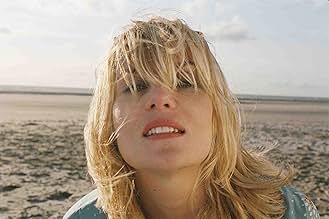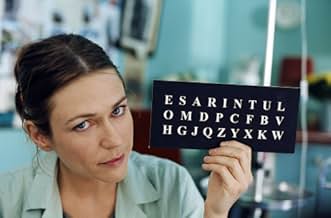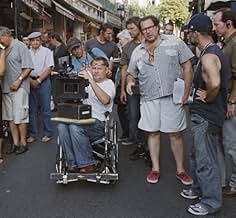L'histoire vraie de Jean-Dominique Bauby, rédacteur en chef du magazine Elle, victime d'un accident vasculaire cérébral et forcé de vivre avec un corps presque totalement paralysé ; seul son... Tout lireL'histoire vraie de Jean-Dominique Bauby, rédacteur en chef du magazine Elle, victime d'un accident vasculaire cérébral et forcé de vivre avec un corps presque totalement paralysé ; seul son oeil gauche est resté en activité.L'histoire vraie de Jean-Dominique Bauby, rédacteur en chef du magazine Elle, victime d'un accident vasculaire cérébral et forcé de vivre avec un corps presque totalement paralysé ; seul son oeil gauche est resté en activité.
- Réalisation
- Scénario
- Casting principal
- Nommé pour 4 Oscars
- 68 victoires et 107 nominations au total
Avis à la une
Saying more about the plot would spoil the wonderful experience of watching "The Diving Bell and the Butterfly". The camera angles/visuals are breathtaking (courtesy of two-time Oscar winning cinematographer Janusz Kaminski), and in some moments he makes us see everything from Bauby's point of view. In spite of Bauby's disability, the film is never overly melodramatic, being similar to (but even better than) "The Sea Inside" and "My Left Foot". The cast is fantastic, from Amalric to screen legend Max von Sydow, and the beautiful women in Jean-Do's life (Marie-Josée Croze, Anne Consigny and Emmanuelle Seigner, among others). The soundtrack is also memorable, including Charles Trenet's wondrous "La Mer" (which was recorded by Bobby Darin in English as "Beyond the Sea"). "The Diving Bell and the Butterfly" won the Golden Globes for best director and foreign film, and got four Oscar nominations (director, adapted screenplay, editing and cinematography - but NOT Best Foreign Film). France made the mistake of submitting the (fantastic) animation "Persepolis" instead of "Diving Bell", but they should know the Academy would never give Best Foreign Film for an animated movie, as good as it might be, and therefore neither of them got the nomination. But that's actually the Academy's fault for their stupid rules, since France should've been allowed to submit both movies. What if two of the best foreign movies of the year were from the same country? In a perfect world, there would be only a Best Picture category and films from any country and any language would be nominated, but since most people still ignore subtitles, this 'segregation' has to exist. Oh well. Oscar blunders apart, this is a film that will make you see and value the beauty of life. Bravo, Mr. Schnabel! Bravo, Monsieur Bauby! 10/10.
This is an anti-Hollywood, anti-formula movie. Those have their place, but this is a great antidote to the silly decisions made by inappropriately powerful studio execs.
See it. You'll be thankful you did.
Beautifully shot by cinematographer Janusz Kaminski with a screenplay by Ronald Harwood, the film begins with Bauby's confused awakening in the hospital after twenty days in a coma. We see only a blur of images and claustrophobic close-ups that mirror the patient's mental state. We can make out a hospital room and doctors and nurses offering reassuring thoughts. We hear Bauby's words but the doctors do not and we know that while his body isn't functioning, his mind is as sharp as ever. With the help of a speech therapist (Marie-Josée Croze), and a very patient transcriber, a code is developed that allows Bauby (Mathieu Amalric), called Jean-Do by his friends and family, to compose a book based on his experience.
When the therapist recites the most-frequently used letters in the French alphabet, Bauby blinks when he wants to choose a letter. The book, on which the film is based, was published in 1997, shortly after Bauby's death. One of the most dramatic moments in the film occurs near the beginning when the first thought Jean-Do communicates is that he wants to die. Feeling rejected and angry, the therapist stomps out of the room but apologizes and comes back shortly to resume the treatment. We do not actually see Jean-Do until about a third of the way through the film but we can hear his thoughts which are in turn angry, funny, and bitterly ironic. Bauby compares his body to a deep-sea diver being suffocated in a diving suit and his poetic imagination to a butterfly.
It is Jean-Do's sense of humor that keeps the film as light as it can be under the circumstances and his eloquence that keeps us riveted. When we finally do see him with his immobile body and his drooping lower lip, it is still a shock but we smile when he says that "I look like I came out of a vat of formaldehyde." Much of the film vividly explores the editor's imagination and the camera takes us on some wild rides that include images of Nijinsky, Empress Eugénie, Marlon Brando, and Jean-Do in his imagination skiing and surfing. Some of the most emotional moments occur when he greets his young children at the beach for the first time after his stroke, a telephone "conversation" with his 92-year old father (Max Von Sydow), and flashbacks to his youth - driving with his girlfriend, shaving his father, supervising a fashion shoot, and taking his son on a trip in a new sports car. Bauby's wife Céline (Emmanuelle Seigner), whom he left for exotic girlfriend Ines (Agathe de La Fontaine), visits him in the hospital and comforts him while Ines cannot bring herself to see him, saying that she wants to remember him the way he was.
Realizing how his life had been less than exemplary, his stroke becomes an opportunity for redemption and allows him, if not to cleanse his soul, to discover that humanity lies in his consciousness not in material things or sexuality. The Diving Bell and the Butterfly is a film of enormous power that shakes us and enables us to get in touch with the miracle of each moment. Schnabel says that his purpose in making the film was to tell "the story of all of us, who surely do face death and sickness. But if we look", he says, "we can find meaning and beauty here." There is enough of both meaning and beauty to make The Diving Bell and the Butterfly one of the best films of the year.
Giving the film a surreal feel as though in a dream we witness a collage of memories, imaginations and actual dreams. From this, along with actual visits from loved ones we get an understanding of the man's life before the accident. It is filmed from the stroke victim's point of view. You see exactly what he sees, such as when his eye gets weak and things get blurry. We are also exposed to the man's thoughts as we hear him talking to the people about his feelings and what he wants to say despite being mute, and not being heard by the people. His thoughts give realness to the character and show us that he is still human. He even finds humor in his situation and says, to the nurse that doesn't hear him, "you need to get a sense of humor".
Overall a message about life. At the peak of this mans life an extremely severe paralysis befalls him. At first understandably pitying himself he is able to find some humor in his situation, (and parts of the movie actually make you laugh) and then inspiration. Inspiration stemming from realization that his imagination and memory are in tact. He can feel good using his mind and can even be creative and productive.
Le saviez-vous
- AnecdotesTo familiarize himself with Bauby's sheltered existence, director Julian Schnabel made the movie in the same hospital where Bauby was treated, meeting many of the orderlies who had treated him. He also shot scenes on the same balcony where Bauby relaxed, and on the same nearby beach to which his family had taken him.
- GaffesWhen Jean-Dominique goes on a boat ride, a 'Speedferries' vessel can be seen in the background. Speedferries started business in 2004, years after the movie was set.
- Citations
Jean-Dominique Bauby: I decided to stop pitying myself. Other than my eye, two things aren't paralyzed, my imagination and my memory.
- Bandes originalesTheme for The Diving-Bell and the Butterfly
Composed by Paul Cantelon
Studio recording The University of Victoria
Engineer / Producer Russell Dawkin
Meilleurs choix
Détails
- Date de sortie
- Pays d’origine
- Site officiel
- Langue
- Aussi connu sous le nom de
- El llanto de la mariposa
- Lieux de tournage
- Sociétés de production
- Voir plus de crédits d'entreprise sur IMDbPro
Box-office
- Montant brut aux États-Unis et au Canada
- 6 003 227 $US
- Week-end de sortie aux États-Unis et au Canada
- 75 721 $US
- 2 déc. 2007
- Montant brut mondial
- 19 780 116 $US
- Durée1 heure 52 minutes
- Couleur
- Mixage
- Rapport de forme
- 1.85 : 1








































